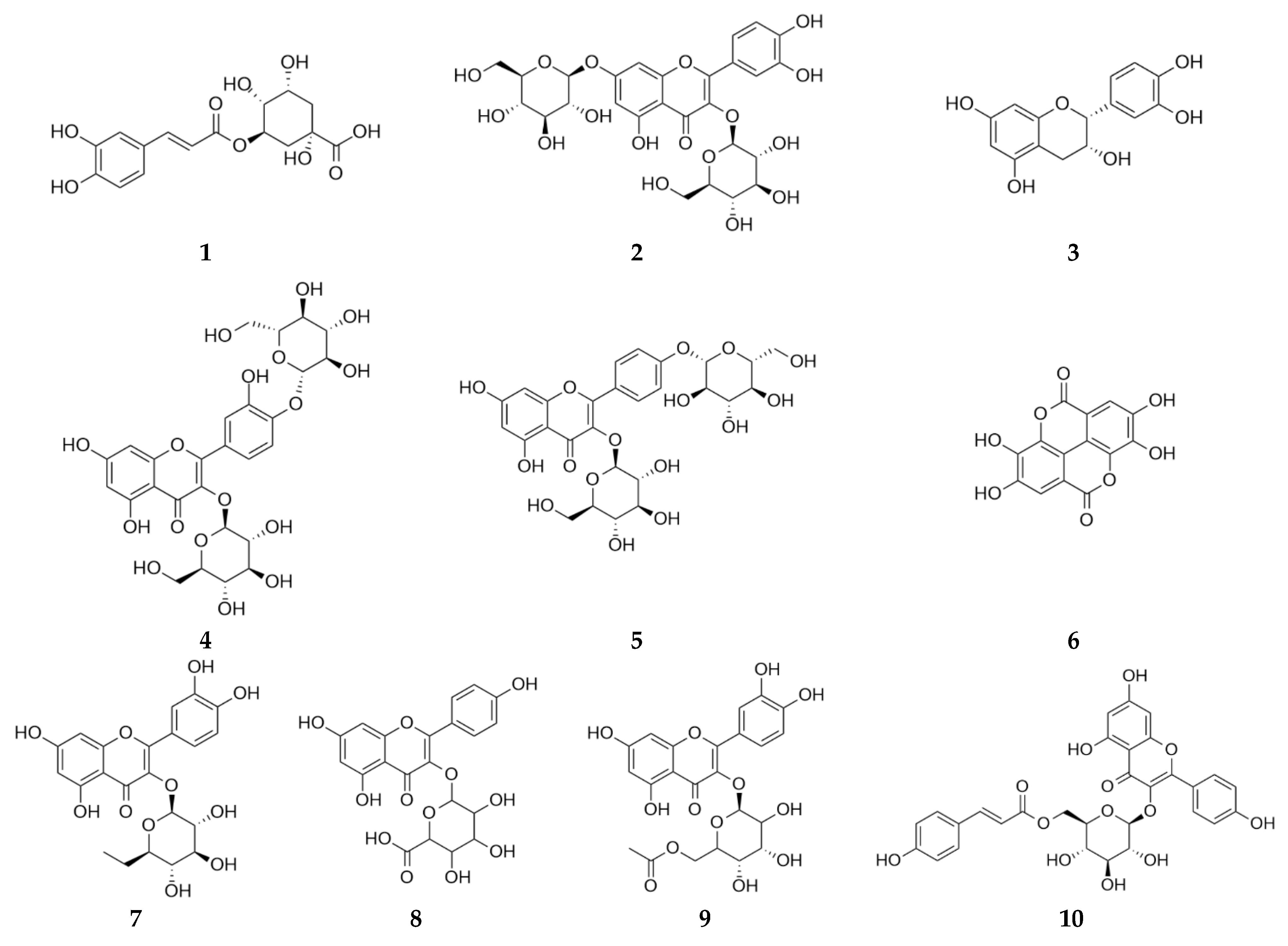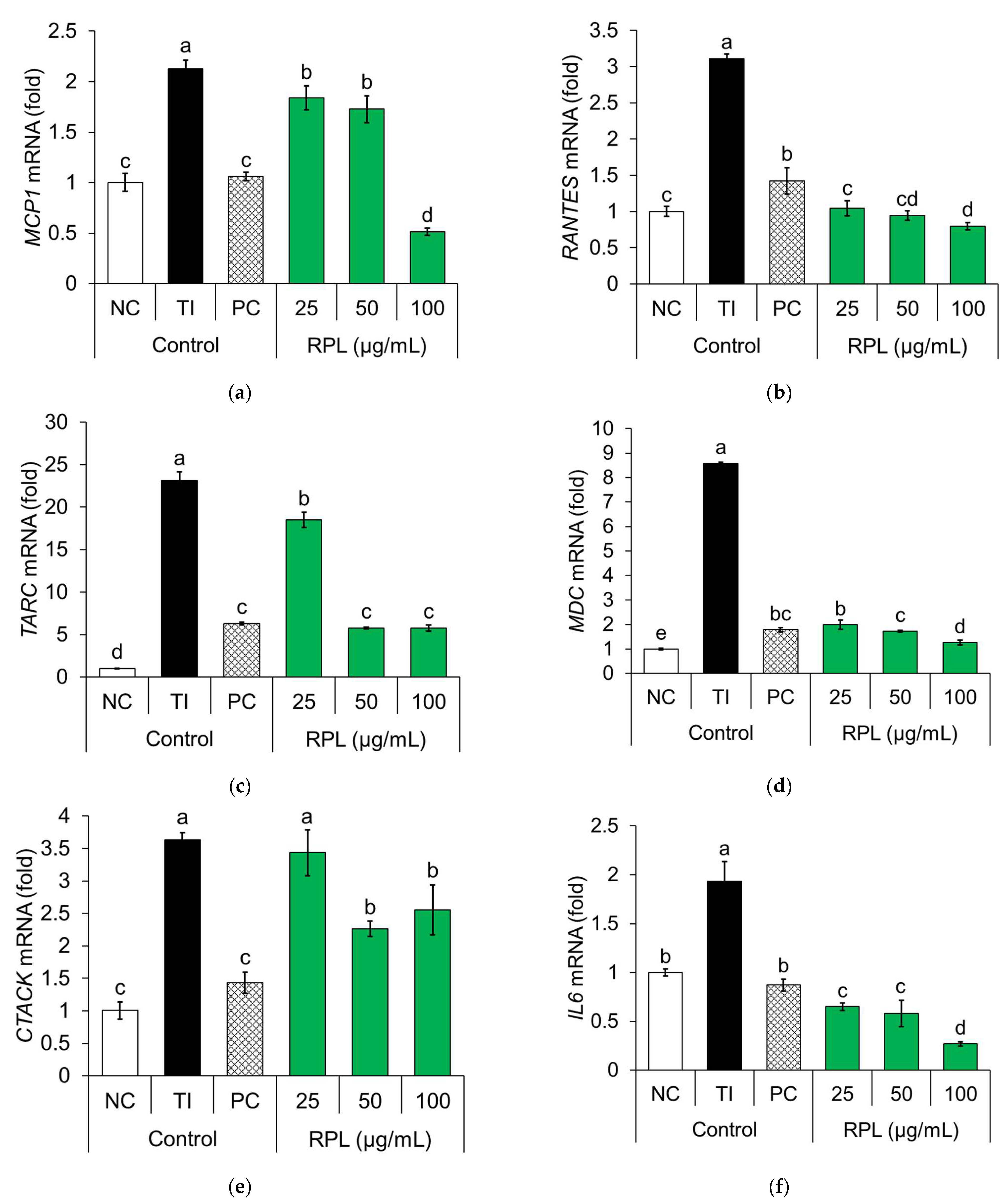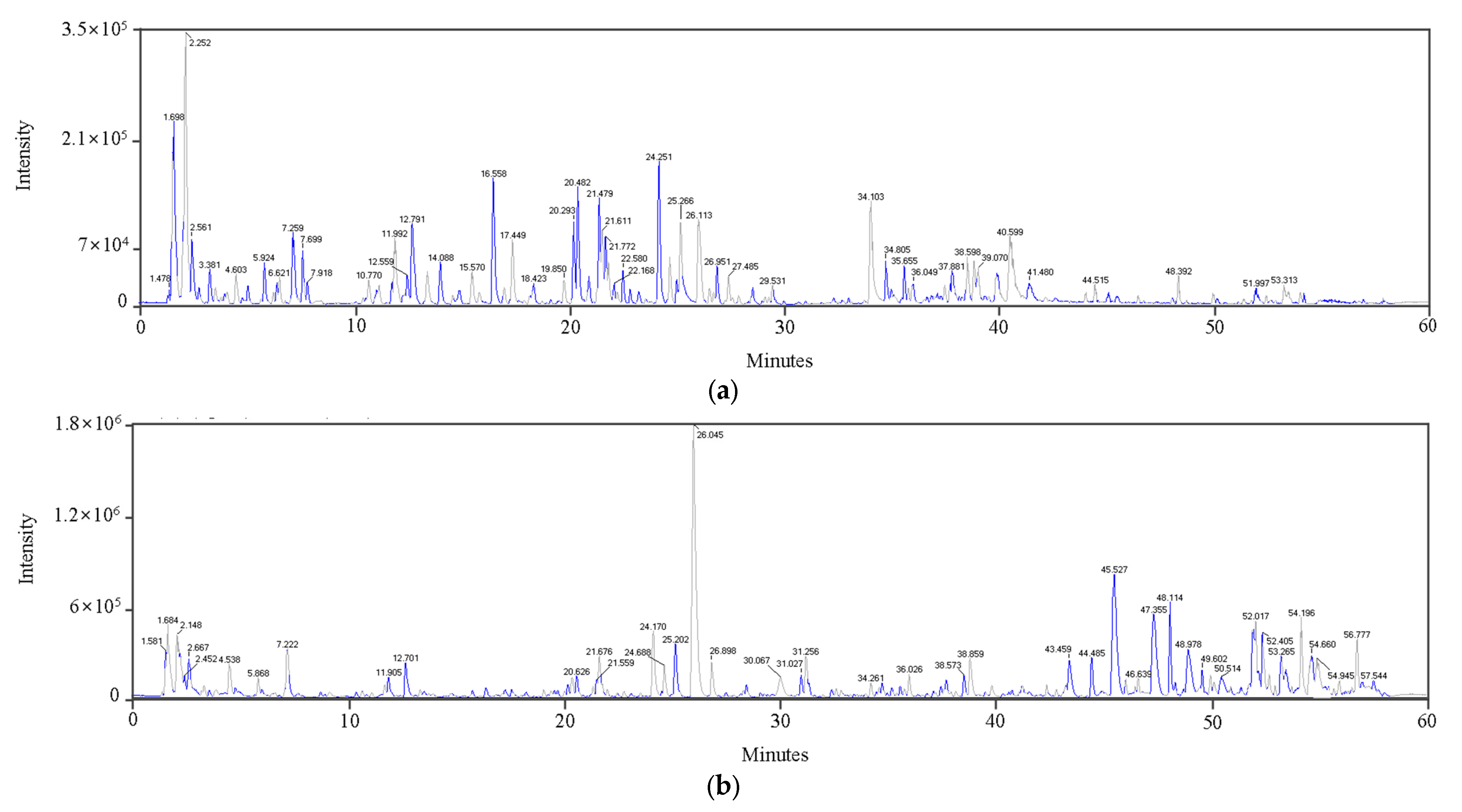Phytochemical Profiling and Anti-Inflammatory Activity of Rubus parvifolius Leaf Extract in an Atopic Dermatitis Model
Abstract
1. Introduction
2. Materials and Methods
2.1. Plant Materials and Sample Preparation
2.2. Chemicals
2.3. Equipment
2.4. Cell Culture for Anti-Inflammatory Evaluation
2.5. ELISA
2.6. qRT-PCR
2.7. Preparation of Samples and Standard Solutions for HPLC
2.8. HPLC/PDA Conditions
2.9. Calibration Curve
2.10. Statistical Analysis
3. Results and Discussion
3.1. Cell Viability and Inflammatory Response
3.2. Inflammatory Gene Expression
3.3. LC-MS and HPLC Analysis
4. Conclusions
Author Contributions
Funding
Data Availability Statement
Acknowledgments
Conflicts of Interest
Abbreviations
| AD | Atopic dermatitis |
| IL-6 | Interleukin-6 |
| IL-8 | Interleukin-8 |
| MCP-1 | Monocyte chemoattractant protein-1 |
| ROS | Reactive oxygen species |
| TNF-α | Tumor necrosis factor-α |
| IFN-γ | Interferon gamma |
| LC-MS/MS | Liquid chromatography-tandem mass spectrometry |
| HPLC | High-performance liquid chromatography |
| RPL | Rubus parvifolius leaf |
| DMEM | Dulbecco’s modified Eagle’s medium |
| MTT | 3-(4,5-Dimethylthiazol-2-yl)-2,5-diphenyltetrazolium bromide |
| FBS | Fetal bovine serum |
| P/S | Penicillin-streptomycin |
| DMSO | Dimethyl sulfoxide |
| ACN | Acetonitrile |
| ELISA | Enzyme-linked immunosorbent assay |
| qRT-PCR | Quantitative reverse transcription PCR |
| TI | TNF-α and IFN-γ |
| PBS | Phosphate-buffered saline |
| RANTES | Regulated upon activation normal T cell expressed and secreted |
| TARC | Thymus and activation-regulated chemokine |
| MDC | Macrophage-derived chemokine |
| CTACK | Cutaneous T cell-attracting chemokine |
| GAPDH | Glyceraldehyde-3-phosphate dehydrogenase |
| DW | Dry weight |
References
- Yamamura, Y.; Nakashima, C.; Otsuka, A. Interplay of cytokines in the pathophysiology of atopic dermatitis: Insights from murine models and human. Front. Med. 2024, 11, 1342176. [Google Scholar] [CrossRef] [PubMed]
- Coondoo, A.; Phiske, M.; Verma, S.; Lahiri, K. Side-effects of topical steroids: A long overdue revisit. Indian Dermatol. Online J. 2014, 5, 416–425. [Google Scholar] [CrossRef]
- Agrawal, R.; Jurel, P.; Deshmukh, R.; Harwansh, R.K.; Garg, A.; Kumar, A.; Singh, S.; Guru, A.; Kumar, A.; Kumarasamy, V. Emerging trends in the treatment of skin disorders by herbal drugs: Traditional and nanotechnological approach. Pharmaceutics 2024, 16, 869. [Google Scholar] [CrossRef] [PubMed]
- Kim, S.J.; Kim, D.S.; Lee, S.H.; Ahn, E.-M.; Kee, J.-Y.; Jong, S.-H. Chelidonic acid ameliorates atopic dermatitis symptoms through suppression of inflammatory mediators in vivo and in vitro. Appl. Biol. Chem. 2023, 66, 12. [Google Scholar] [CrossRef]
- Lee, S.H.; Oh, Y.; Bong, S.K.; Lee, J.W.; Park, N.-J.; Kim, Y.-J.; Park, H.B.; Kim, Y.K.; Kim, S.H.; Kim, S.-N. Paedoksan ameliorates allergic disease through inhibition of the phosphorylation of STAT6 in DNCB-induced atopic dermatitis-like mice. Appl. Biol. Chem. 2023, 66, 58. [Google Scholar] [CrossRef]
- Yang, J.H.; Lee, E.; Lee, B.; Cho, W.K.; Ma, J.Y.; Park, K.I. Ethanolic extracts of Artemisia apiacea Hance improved atopic dermatitis-like skin lesions in vivo and suppressed TNF-α/IFN-γ–induced proinflammatory chemokine production in vitro. Nutrients 2018, 10, 806. [Google Scholar] [CrossRef]
- Sohn, Y.W.; Yoo, S.M. Antioxidative and whitening effects of Rubus parvifolius L. extract on dermal cytotoxicity of ZnSO4, mordant. J. Converg. Inf. Technol. 2021, 11, 199–205. [Google Scholar] [CrossRef]
- Cao, J.; Zhao, X.; Ma, Y.; Yang, J.; Li, F. Total saponins from Rubus parvifolius L. inhibits cell proliferation, migration and invasion of malignant melanoma in vitro and in vivo. Biosci. Rep. 2020, 41, BSR20201178. [Google Scholar] [CrossRef]
- Alharshani, E.M.; El-Hawary, S.S.; Abdelkader, E.M.; Ismail, S.A.; Abdelhameed, M.F.; Kirollos, F.N.; El Raey, M.A. Exploring the impact of Rubus ulmifolius leaf cream on wound healing in an in vivo model: VEGF, PDGF, and cytokine dynamics. Burns 2025, 51, 107634. [Google Scholar] [CrossRef]
- Gudej, J.; Tomczyk, M. Determination of flavonoids, tannins and ellagic acid in leaves from Rubus L. species. Arch. Pharm. Res. 2004, 27, 1114–1119. [Google Scholar] [CrossRef]
- Kim, J.T.; Kim, K.H.; Hwang, J.Y.; Chung, C.W.; Won, W.Y.; Kim, J.S. Quercetin inhibits inflammation responses via MAPKs and NF-κB signaling pathways in LPS-stimulated RAW264.7 cells. J. Life Sci. 2022, 32, 899–907. [Google Scholar] [CrossRef]
- Baek, B.; Lee, S.H.; Kim, K.; Lim, H.W.; Lim, C.J. Ellagic acid plays a protective role against UV-B-induced oxidative stress by up-regulating antioxidant components in human dermal fibroblasts. Korean J. Physiol. Pharmacol. 2016, 20, 269–277. [Google Scholar] [CrossRef] [PubMed]
- Kim, E.K.; Kwon, J.E.; Lee, S.Y.; Lee, E.J.; Kim, D.S.; Moon, S.J.; Cho, M.L. Inhibitory effect of kaempferol on skin fibrosis in systemic sclerosis by the suppression of oxidative stress. J. Dermatol. Sci. 2019, 96, 8–17. [Google Scholar] [CrossRef] [PubMed]
- Kim, Y.-K.; Cho, M.; Kang, D.-J. Anti-inflammatory response of new postbiotics in TNF-α/IFN-γ-induced atopic dermatitis-like HaCaT keratinocytes. Curr. Issues Mol. Biol. 2024, 46, 6100–6111. [Google Scholar] [CrossRef]
- Mi, X.-J.; Kim, J.-K.; Lee, S.; Moon, S.-K.; Kim, Y.-J.; Kim, H. In vitro assessment of the anti-inflammatory and skin-moisturizing effects of Filipendula palmata (Pall.) Maxim. on human keratinocytes and identification of its bioactive phytochemicals. J. Ethnopharmacol. 2022, 296, 115523. [Google Scholar] [CrossRef]
- Yuan, W.; Jiuming, H.; Hui, C.; Disheng, Z.; Hua, C.; Huibo, S. Analysis of flavones in Rubus parvifolius Linn by high performance liquid chromatography combined with electrospray ionization-mass spectrometry and thin-layer chromatography combined with Fourier transform surface enhanced Raman spectroscopy. Chin. J. Anal. Chem. 2006, 34, 1073–1077. [Google Scholar] [CrossRef]
- Jodynis-Liebert, J.; Kujawska, M. Biphasic dose-response induced by phytochemicals: Experimental evidence. J. Clin. Med. 2020, 9, 718. [Google Scholar] [CrossRef]
- Jung, H.Y.; Nam, K.N.; Woo, B.C.; Kim, K.P.; Kim, S.O.; Lee, E.H. Hirsutine, an indole alkaloid of Uncaria rhynchophylla, inhibits inflammation-mediated neurotoxicity and microglial activation. Mol. Med. Rep. 2013, 7, 154–158. [Google Scholar] [CrossRef]
- Pyeon, S.; Kim, O.K.; Yoon, H.G.; Kim, S.; Choi, K.C.; Lee, Y.H.; Lee, J.; Park, J.; Jun, W. Water extract of Rubus coreanus prevents inflammatory skin diseases in vitro models. Plants 2021, 10, 1230. [Google Scholar] [CrossRef]
- Kim, M.Y.; Choi, M.Y.; Nam, J.H.; Park, H.J. Quantitative analysis of flavonoids in the unripe and ripe fruits and the leaves of four Korean Rubus species. Korean J. Pharmacogn. 2008, 39, 123–126. [Google Scholar]
- Kaur, G.; Kaur, J.; Goyal, J.; Vaid, L.; Singh, T.G.; Singh, R.; Devi, S. Multifaceted role of tiliroside in inflammatory pathways: Mechanisms and prospects. Recent Adv. Inflamm. Allergy Drug Discov. 2024, 19, 316–327. [Google Scholar] [CrossRef]
- Zawawi, N.A.; Ahmad, H.; Madatheri, R.; Fadilah, N.I.M.; Maarof, M.; Fauzi, M.B. Flavonoids as natural anti-inflammatory agents in the atopic dermatitis treatment. Pharmaceutics 2025, 17, 261. [Google Scholar] [CrossRef] [PubMed]
- Beken, B.; Serttas, R.; Yazicioglu, M.; Turkekul, K.; Erdogan, S. Quercetin improves inflammation, oxidative stress, and impaired wound healing in atopic dermatitis model of human keratinocytes. Pediatr. Allergy Immunol. Pulmonol. 2020, 33, 69–79. [Google Scholar] [CrossRef] [PubMed]
- Gil, T.Y.; Hong, C.H.; An, H.J. Anti-inflammatory effects of ellagic acid on keratinocytes via MAPK and STAT pathways. Int. J. Mol. Sci. 2021, 22, 1277. [Google Scholar] [CrossRef] [PubMed]
- Kim, H.J.; Shin, K.J.; Htwe, K.M.; Yoon, K.D. A new vomifoliol derivative and flavonoids from the aerial parts of Orthosiphon aristatus. Nat. Prod. Sci. 2024, 30, 72–85. [Google Scholar] [CrossRef]
- Yang, S.C.; Chang, Z.Y.; Hsiao, C.Y.; Alshetaili, A.; Wei, S.H.; Hsiao, Y.T.; Fang, J.Y. Topical anti-inflammatory effects of quercetin glycosides on atopic dermatitis-like lesions: Influence of the glycone type on efficacy and skin absorption. Inflammation 2025, 48. Epub ahead of print. [Google Scholar] [CrossRef]
- Nasanbat, B.; Uchiyama, A.; Amalia, S.N.; Inoue, Y.; Yokoyama, Y.; Ogino, S.; Torii, R.; Hosoi, M.; Motegi, S. Kaempferol therapy improved MC903-induced atopic dermatitis in a mouse by suppressing TSLP, oxidative stress, and type 2 inflammation. J. Dermatol. Sci. 2023, 111, 93–100. [Google Scholar] [CrossRef]
- Pennesi, C.M.; Neely, J.; Marks, A.G.; Basak, S.A. Use of isoquercetin in the treatment of prurigo nodularis. J. Drugs Dermatol. 2017, 16, 1156–1158. [Google Scholar]
- Morikawa, K.; Nonaka, M.; Narahara, M.; Torii, I.; Kawaguchi, K.; Yoshikawa, T.; Kumazawa, Y.; Morikawa, S. Inhibitory effect of quercetin on carrageenan-induced inflammation in rats. Life Sci. 2003, 74, 709–721. [Google Scholar] [CrossRef]





| Target | Primer Sequence (5′ to 3′) |
|---|---|
| Glyceraldehyde-3-phosphate dehydrogenase (GAPDH) | GTCTTCACCACCATGGAGAA AGGAGGCATTGCTGATGAT |
| Monocyte chemoattractant protein 1 (MCP-1) | TCAAACTGAAGCTCGCACTCT GGCATTGATTGCATCTGGC |
| Normal T cell expressed and secreted (RANTES) | CATATTCCTCGGACACCACACCCT ACTCCTGACCTCAAGTGATCCACC |
| Thymus and activation-regulated chemokine (TARC) | GCAGCTCGAGGGACCAATGT TTGGGGTCCGAACAGATGGC |
| Macrophage-derived chemokine (MDC) | AGGACAGAGCATGGCTCGCCTACAG TAATGGCAGGGAGGTAGGGCTCCTG |
| Cutaneous T Cell-Attracting Chemokine (CTACK) | CACTGCCTGCTGTACTCAGCTCTA CTTCAGCCCATTTTCCTTAGCATC |
| Interleukin 6 (IL-6) | GTGTGAAAGCAGCAAAGAGGC CTGGAGGTACTCTAGGTATAC |
| tR (min) | MW | Tentative Identification |
|---|---|---|
| 12.30 | 578.1 | Procyanidin B2 1 |
| 13.54 | 626.1 | Quercetin 3,7-diglucoside 1,2 |
| 14.20 | 290.1 | Epicatechin 1,2 |
| 15.45 | 610.2 | Kaempferol 3,4′-di-O-glucoside 1,2 |
| 19.83 | 610.2 | Rutin 1 |
| 19.96 | 464.1 | Hyperoside 2 |
| 20.04 | 302.0 | Ellagic acid 1 |
| 20.07 | 478.1 | Quercetin glucuronide 2 |
| 20.37 | 464.1 | Hirsutrin 1,2 |
| 21.21 | 506.1 | Quercetin 3-O-glucose-6″-acetate 1 |
| 21.65 | 462.1 | Kaempferol 3-O-glucuronide 1,2 |
| 21.70 | 448.1 | Maritimein 1,2 |
| 23.95 | 368.1 | 5-O-Caffeoylquinic acid methyl ester 1,2 |
| 24.35 | 666.4 | 1-O-(20,24-Epoxy-1,3,25-trihydroxy-28-oxo-9,19-cyclolanostan-28-yl)-hexopyranose 1 |
| 24.88 | 302.0 | Quercetin 1,2 |
| 25.21 | 594.1 | Tiliroside 1,2 |
| 37.82 | 504.3 | Madecassic acid 1,2 |
| 45.56 | 456.4 | Oleanolic acid 2 |
| Sample | Standard Compound (mg/g DW) | ||||||||||
|---|---|---|---|---|---|---|---|---|---|---|---|
| 1 | 2 | 3 | 4 | 5 | 6 | 7 | 8 | 9 | 10 | Total | |
| RPL | ND | 12.73 ± 0.14 | ND | ND | ND | 1.58 ± 0.01 | 4.74 ± 0.04 | 0.31 ± 0.01 | ND | trace | 19.36 |
Disclaimer/Publisher’s Note: The statements, opinions and data contained in all publications are solely those of the individual author(s) and contributor(s) and not of MDPI and/or the editor(s). MDPI and/or the editor(s) disclaim responsibility for any injury to people or property resulting from any ideas, methods, instructions or products referred to in the content. |
© 2025 by the authors. Licensee MDPI, Basel, Switzerland. This article is an open access article distributed under the terms and conditions of the Creative Commons Attribution (CC BY) license (https://creativecommons.org/licenses/by/4.0/).
Share and Cite
Kim, J.; Kakooza, D.; Lee, C.-D.; Jung, S.-Y.; Choi, K.; Moon, S.-K.; Kim, H.; Lee, S. Phytochemical Profiling and Anti-Inflammatory Activity of Rubus parvifolius Leaf Extract in an Atopic Dermatitis Model. Life 2025, 15, 1383. https://doi.org/10.3390/life15091383
Kim J, Kakooza D, Lee C-D, Jung S-Y, Choi K, Moon S-K, Kim H, Lee S. Phytochemical Profiling and Anti-Inflammatory Activity of Rubus parvifolius Leaf Extract in an Atopic Dermatitis Model. Life. 2025; 15(9):1383. https://doi.org/10.3390/life15091383
Chicago/Turabian StyleKim, Junseong, Derrick Kakooza, Chang-Dae Lee, Su-Young Jung, Kyung Choi, Sung-Kwon Moon, Hoon Kim, and Sanghyun Lee. 2025. "Phytochemical Profiling and Anti-Inflammatory Activity of Rubus parvifolius Leaf Extract in an Atopic Dermatitis Model" Life 15, no. 9: 1383. https://doi.org/10.3390/life15091383
APA StyleKim, J., Kakooza, D., Lee, C.-D., Jung, S.-Y., Choi, K., Moon, S.-K., Kim, H., & Lee, S. (2025). Phytochemical Profiling and Anti-Inflammatory Activity of Rubus parvifolius Leaf Extract in an Atopic Dermatitis Model. Life, 15(9), 1383. https://doi.org/10.3390/life15091383








